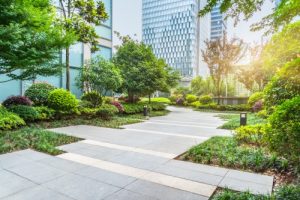Sustainable Landscaping Tips for Your Building
Sustainability has become an important goal for commercial real estate, including landscape architecture and design. In fact, the state of California has developed a set of municipal and statewide guidelines for landscaping around commercial buildings and industrial zones.
One of the more important set of guidelines is the Model Water Efficient Landscaping Ordinance (MWELO), which seeks to curb excessive water use in outdoor landscaping. Among other things, MWELO reduces the allowable amount of high water use plants to "special landscape areas" and sets a maximum water allowance for both residential and commercial landscape projects. First implemented in 2015, MWELO is set to be revised, with the goal of stricter compliance, in 2020.
With water scarcity continuing to be an issue for many parts of California, planning a drought-tolerant landscape around your commercial property is just the smartest way to go. Combined with other sustainability measures, like the strategic use of landscaping to regulate the temperature of the building itself, you can reduce overall cost of maintaining an attractive landscape while at the same time protecting the environment.
Here are some tips for getting started.

Introduce More Native Plants
Xeriscaping is the use of plants that need less water, reducing the need for supplemental irrigation. Although you can introduce non-native species that are suited to the hardiness zone of your area, native plants are already adapted to local drought conditions and don't run the risk of becoming invasive. Because they are also less likely to become stressed by the environment, native perennials are a more renewable alternative to annuals that need to be replaced several times a year.
Conserve Water
The biggest water hog of all is turf grass. One of the simplest ways to cut your water bill and boost sustainability is to reduce the amount of space in your landscape design devoted to lawn areas. Other tips for cutting water are regular inspection and maintenance of your irrigation system and adjusting the watering schedule both to minimize evaporation and to meet the specific needs of your landscaping plants.
Deter Pests Naturally
Some plants, such as bee balm, rosemary, and pennyroyal, contain compounds that deter mosquitos, making them desirable additions to a commercial landscape. Other ways of deterring pests naturally include introducing beneficial insects and planting species that attract them, like purple coneflower. You can also cut down on pests by selecting hardy species.
Use Trees Effectively
Trees are a boon to commercial landscape for a number of reasons. They provide shade for people who want to take a break outdoors. They shelter outdoor structures, like playscapes and benches, from the heat of the day. They add interest to the landscape and provide a barrier to cut down noise. Lastly, their foliage can help to regulate the indoor temperature of a building by providing a windbreak and screening out the sun's rays.
Consider Green Roofing
For commercial builders willing to absorb the initial higher cost of installing a green, or living, roof, the rewards can pay off. According to the EPA, green roofs remain 30 to 40 degrees cooler than traditional roofing, and they help to reduce the ambient temperature of the entire city. They are also cost-effective, reducing peak electricity demand and contributing to a savings of $0.23 per square foot of the roof's surface area.
Click here for a list of BOMA/GLA member landscape professionals for more information on how you can improve your building's sustainable landscape practices.

